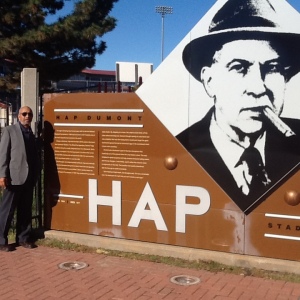
Talk about a coincidence. I travelled to Wichita, Kansas with my wife who had a speaking engagement a week ago this past November 2. Upon arriving at our hotel the afternoon before, I discovered that in my haste to pack for the trip, I did not bring the current book I was reading; Color Blind: The Forgotten Team That Broke Baseball’s Color Line by Tim Dunkel (Atlantic Press, New York, 2013). The inner self-scolding I was giving myself for leaving the book was interrupted by my wife. She wanted to determine the travel time to where she was to speak the next morning.
A little more than a block from the hotel on our exploratory search for Wichita’s Exploration Place, we drove passed Lawrence-Dumont Stadium; home field of the annual National Baseball Congress. Coincidentally, Dunkel’s book is about the NBC’s first tournament in 1935 won by a mixed raced team from Bismarck, North Dakota whose star pitcher was Satchel Paige.
But baseball racial integration took another step at the semi-pro level during the early 1930s in rural North Dakota. Negro League players were being recruited to improve the previously all white semi-professional team in many towns. The city of Bismarck, the North Dakota capital, had six players with Negro League baseball experience on its team in 1935; Satchel Paige, Hilton Smith, Red Haley, Barney Morris, Quincy Troupe, and Ted “Double Duty” Radcliffe. It was the best semi-professional team in the state.
But to get more attention for his initial tournament Dumont invited four African American teams, the Memphis Red Sox, Monroe (La.) Monarchs, Austin (Texas) Centennials, and San Angelo (Texas) Sheepherders. He also invited the mixed race team from North Dakota, who added Negro League pitcher Chet Brewer to its tournament roster. Many white teams, especially those from southern cities, complained about having to play against African Americans, but Dumont kept to his plan for that first tournament.
Bismarck’s success in that first NBC tournament made no dent in the racial policies of professional baseball. The Major Leagues remained “all white” for 12 more years. Even “Hap” Dumont gave in to complaints from white participants in the tournament and by 1940 the NBC affiliate leagues eliminated African American teams from participation.
African Americans did not return to the NBC tournament until the l950s and it by then had changed its focus to players of amateur status, primarily college age players. Today the NBC has one of the oldest and biggest amateur baseball tournaments in the country with African American alumni such as Barry Bonds, Dave Winfield, Tony Gwynn, and Joe Carter.
Read more about the journey of Negro League baseball in my book “Last Train to Cooperstown: The 2006 Baseball Hall of Fame Inductees from the Negro League Baseball Era”. For more information, go to www.klmitchell.com or http://booklaunch.io/kevinlmitchell/last-train-to-cooperstown.
No comments:
Post a Comment